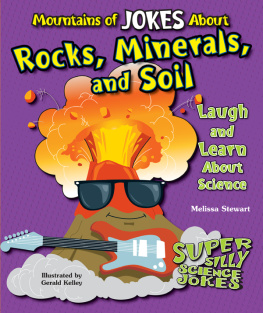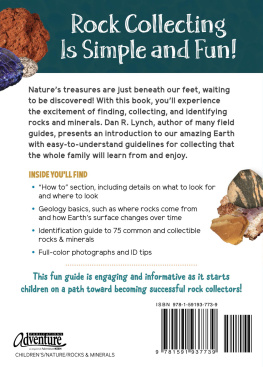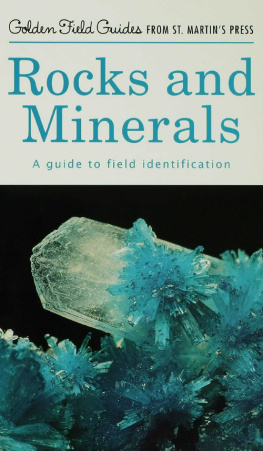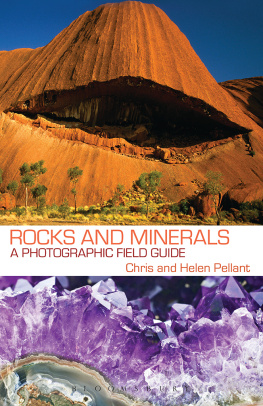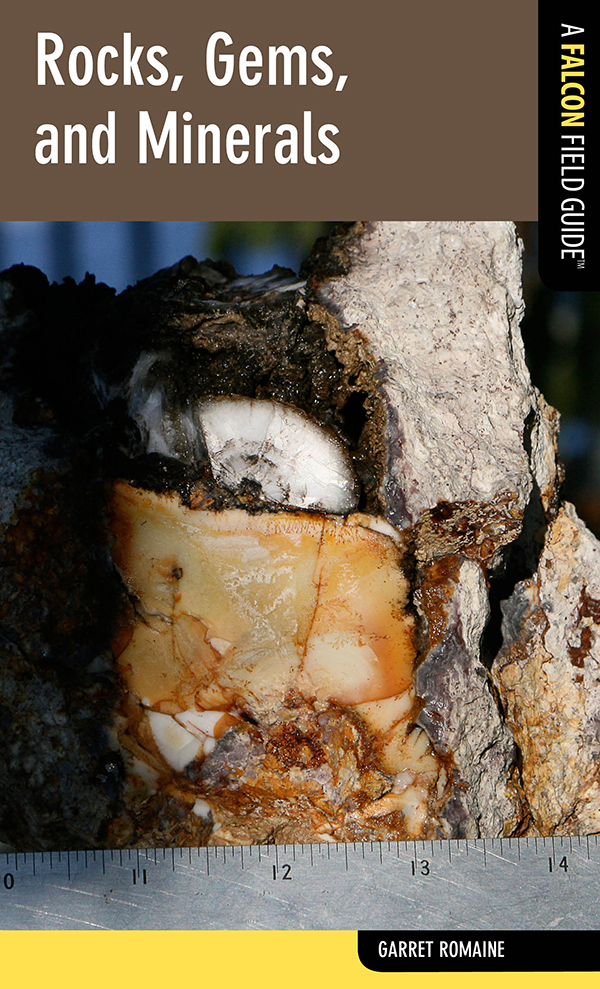Rocks, Gems, and Minerals
Garret Romaine
To my uncle Doug, who never turned down a chance to head out to the field.
Copyright 2013 by Morris Book Publishing, LLC
ALL RIGHTS RESERVED. No part of this book may be reproduced or transmitted in any form by any means, electronic or mechanical, including photocopying and recording, or by any information storage and retrieval system, except as may be expressly permitted in writing from the publisher. Requests for permission should be addressed to Globe Pequot Press, Attn: Rights and Permissions Department, P.O. Box 480, Guilford, CT 06437.
Falcon, FalconGuides, and Outfit Your Mind are registered trademarks of Morris Book Publishing, LLC.
Interior photos by Garret Romaine except where otherwise credited.
Project editor: Heather Santiago
Text design: Sheryl P. Kober
Layout: Sue Murray
Library of Congress Cataloging-in-Publication Data is available on file.
ISBN 978-0-7627-9075-3
The author and Globe Pequot Press assume no liability for accidents happening to, or injuries sustained by, readers who engage in the activities described in this book.
Contents
Acknowledgments
I owe a lot of people a huge debt of gratitude. At Portland State University, Dr. Martin J. Streck pulled some amazing specimens from his mineralogy lab so I could show you a real hornfels and a true graywacke. Tim Fisher, producer of the Ore-Rock-On DVD that pinpoints 2,700 collecting locales throughout the Pacific Northwest, has been a valuable resource and friend over the years. Lanny Ream, veteran field geologist and author of several excellent books on local rockhounding and field collecting, has proved to be a great resource, as has Bob Jackson, owner of Geology Adventures, the Spruce Ridge mine, and the Rock Candy mine. Rudy Tschernich, former curator of the Rice Museum in Hillsboro, Oregon, and author of Zeolites of the World, has been a huge help over the years. Martin Schippers, Dirk Williams, Frank Higgins, Val Bailey, Terry Snider, and Jake Riley have been particularly helpful on recent expeditions to explore this great country.
On the production side, Kleur Pre-Media Services in Lynnwood, Washington, tirelessly tuned up the photographs for me. Rachel Houghton helped with the photography and the manuscripts. Numerous rock shops and museums allowed me to photograph their specimens that were better than mine. I owe a special thanks to Eds House of Gems and Jim Smith at Earthly Treasures for letting me bring my camera to their shops.
I especially want to thank Melena Wallace, executive director of the famed Rice Northwest Museum of Rocks and Minerals in Hillsboro, Oregon, for access to their fantastic collection, with numerous specimens gracing these pages.
Finally, my family deserves thanks. My uncle Doug Romaine has been a wonderful advisor over the years, encouraging me to first seek a geology degree and then leading me on adventures all over the West. This book is dedicated to him. And special thanks to my wife, Cindy, and the kids for putting up with a lifetime of talking about rocks.
Introduction
Goal of This Guide
The goal of this guide is to get you started from a casual observer to a competent rockhound, able to identify the most common rocks and minerals around you. In the ranking of this profession, there are many stages (left to right, increasing expertise):
| Casual Observer | Pebble Pup | Rockhound | Prospector | Field Geologist | Mining Engineer |
With this book you could conceivably make Prospector rank, able to at least classify just about anything, and know enough to be on the lookout for the rare and unusual. You need a lot more book learnin to advance beyond capable prospector, able to direct the work of others. The vocabulary lesson alone that underpins geology is daunting. This book is intended as a gateway to collecting wonderful samples and improving your ability to identify what you see around you. But avoid the get-rich-quick attitude of a Yukon stampeder. Concentrate on building your own personal specimen cabinet, well stocked with samples you gather and augmented by what you have to buy for completeness. If you stumble upon a diamond mine or a ledge of emeralds, at least share the pictures. But dont expect it. Have fun, be safe, and dont quit your day job first.
About Geology
The term geology is a combination of two Greek words: Geo refers to the earth, and logos refers to the logic and language used to explain things. So think of geology as a way to organize and talk about the earths processes. There are many things we can only guess at, so we base our theories on lab experiments and inferences that take many detailed drawings to explain and a lifetime to understand. Fortunately the more you see, the better things fall into place.
Geology is a young science, dating to 1815 if you start with William Smiths first geology map. Ancient Greeks, such as Pliny the Elder, had described minerals and metals, and many early scholars documented the metal mines of the times. Some of the smartest and most educated scientists laid down the basics, such as Nicolas Steno (163856), who observed that most of the time, the rocks at the bottom of a cliff are older than the rocks at the top. He called that the Law of Superposition, and it helped explain how fossil seashells ended up on mountaintops. He also developed the Principle of Original Horizontality: Sedimentary rocks are usually deposited flat, although there can be local pinching, advancing, and other variations. James Hutton presented his Theory of the Earth in 1785, Smith published a geology map of England in 1815, and then in 1830 Sir Charles Lyell wrote Principles of Geology. Great thinkers argued over whether geology happened in slow, methodical processes or in short, catastrophic bursts. Once these learned philosophers learned to measure the astonishing age of the earth4.6 billion yearsthey realized that both arguments were true.
There are two key points to consider in geology: time and entropy.
- Time. Earth is a very young planet and thus still very active. Its also pretty old, so its all relative. Given enough time, a lot can happen on a young, geologically active planet. We have earthquakes, volcanoes, and moving continents, all stemming from the forces that boil up from the earths magnetic core. Some activities happen quickly, like tsunamis. Other forces take millions of years, leaving only subtle clues, like all the mica flakes lined up in a schist. Good field observers can identify the obvious signs of things that seemed to happen before and apply those signs to the present and future.
- Entropy. Things fall apart all the time. Stuff happens. Storms rearrange coastlines and rework river channels. Earthquakes, volcanoes, storms, and floods all move mountains and leave scars that heal. A rock balanced precariously atop another rock will not remain there for long; eventually it will shake loose. Earth is very efficient at recycling all that surface mayhem, hiding many clues. Mountains rise then get ground down under glaciers and unrelenting rain. Tight chemical bonds that hold atoms together eventually weaken thanks to water, heat, pressure, and time. Oxygen in the air constantly rusts iron and dissolves minerals. Those forces are always at work and easy to predict but sometimes hard to imagine.


